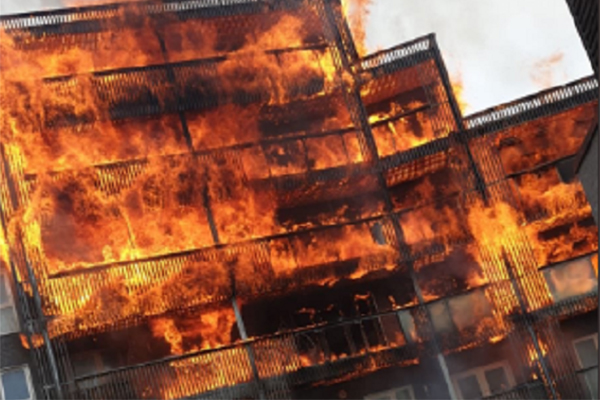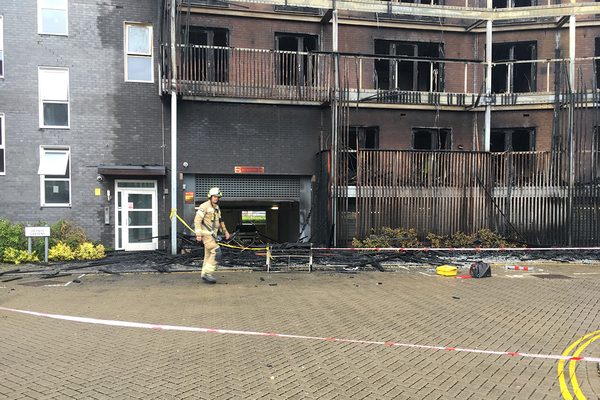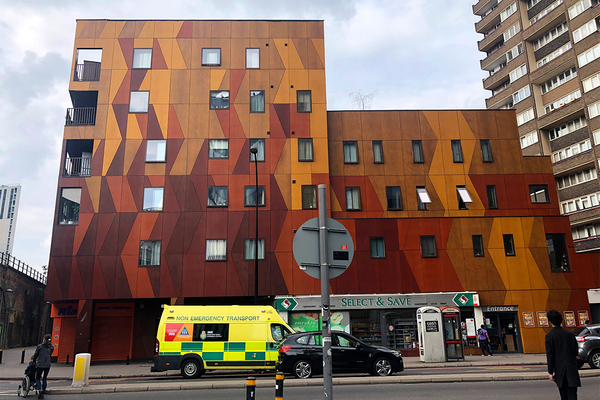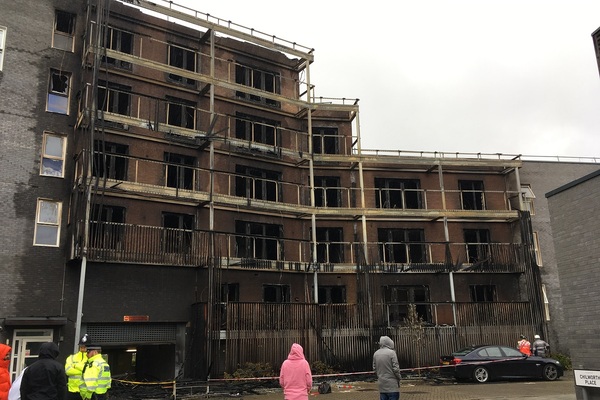You are viewing 1 of your 1 free articles
 Jules Birch
Jules BirchBarking fire makes the urgent need for action only too clear
The horrific fire in Barking on Sunday is a reminder that there is much to do when it comes to residents’ safety, writes Jules Birch
Almost two years on from Grenfell, Sunday’s huge fire at a block of flats in Barking is a horrifying reminder of how much there is still to do to keep residents safe.
Thankfully, everyone seems to have got out but the parallels are all too clear in the terrifying speed at which the fire spread and previous safety concerns raised by residents of the mixed-tenure block that appear to have been brushed aside.
Attention will inevitably focus on the safety of timber balconies and the apparent failure of fire-retardant treatment of the materials used, as well as the actions of those responsible for the block.
More broadly, it underlines a whole series of questions about regulation and the construction industry and relationships between developers, freeholders and leaseholders that have still not had adequate answers.
With only a few days until the second anniversary of the Grenfell tragedy, the fire is a dramatic illustration of how much remains to be done to meet Theresa May’s pledge to do “whatever it takes… to keep our people safe”.
And we are also only three weeks away from the 10th anniversary of the fire at Lakanal House that led to coroner’s recommendations that were sidelined before Grenfell and have still not been fully implemented.
“Sunday’s huge fire at a block of flats in Barking is a horrifying reminder of how much there is still to do to keep residents safe”
In a Commons debate last Thursday, MP after MP criticised the government on the speed of its response to both fires.
Most immediately, Kensington’s Labour MP Emma Dent Coad raised the plight of the 19 families from Grenfell Tower and Grenfell Walk and the 109 families in the walkways attached to the tower who are still homeless, the impact of the fire on the mental and physical health of residents, and the slow progress of the public inquiry and police investigation.
But much of the focus was on broader issues of fire safety, on the plight of thousands of residents of blocks that still have Grenfell-style aluminium composite material (ACM) cladding and of potentially thousands more who live in blocks with other types of cladding that could be just as dangerous, and on fire hazards in non-residential buildings.
Just before the debate started, the Ministry of Housing, Communities and Local Government published its proposals on a new building safety regime that implements recommendations made by Dame Judith Hackitt, but also goes further.
Meanwhile, the Home Office launched a call for evidence on whether the Regulatory Reform (Fire Safety) Order 2005 – seen as one of the deregulatory steps on the road to Grenfell – is fit for purpose.
These will have addressed some of the concerns raised by MPs but what became abundantly clear during the debate is that the steps taken by the government so far do not go remotely far enough to satisfy them.
The mood was summed up by Conservative MP Paul Scully: “Some lessons have already been learned, but there are plenty more. Whether it is about the response of the fire services, the cladding or the building regulations, we need to learn these lessons to ensure that this can never happen again.
“Whether it is Lakanal House or other fires, how many times have we said in this place ‘this must never happen again’ and then similar things have happened again?”
Tory MP David Amess summed up the frustration of members of the All-Party Parliamentary Fire Safety & Rescue Group: “Over the past six years, the all-party group has met resistance when seeking improvements to fire safety, despite compelling evidence that such measures should be introduced. In the 13 years since regulations were last reviewed, nothing has happened.”
He credited housing secretary James Brokenshire for acting on combustible materials on new high rises and desktop studies, and for extending cladding removal funding to the private sector.
But he went on: “The building regulations must be reviewed. We have to stop messing about. We want a proper audit, so there is retrospective fitting of sprinklers in all high-rise buildings.”
Labour’s Clive Betts, chair of the Housing, Communities and Local Government Committee, said that the government’s response since Grenfell had at least recognised that potentially dangerous material needs to be removed.
But it had taken until a year after Grenfell for the government to come up with cladding funding for social landlords and then virtually another year to come up with a fund for private blocks.
And he raised a series of questions about the scope of the fund and the responsibility for signing off the work, about the laxity of the testing regime for cladding materials and about the situation with up to 1,600 blocks with non-ACM cladding that could be just as dangerous.
“How can we possibly say that it is too risky to put materials that are not of limited combustibility on new buildings, if we are happy for such materials to remain on existing buildings?” he asked.
Labour’s Karen Buck said that Grenfell was “a defining moment of British politics” and that it “should have been the event that changed everything” and generated “a new era for social housing”, but “we have not seen action from the government”.
The speed in which this fire in #barking spread was crazy! Nothing learned from #Grenfell #barkingfire pic.twitter.com/5mdceE4pAS
— MARAJA (@MARAJA_7)The speed in which this fire in #barking spread was crazy! Nothing learned from #Grenfell #barkingfire pic.twitter.com/5mdceE4pAS
— MARAJA (@MARAJA_7) June 9, 2019
She said that the retrofitting of sprinklers had stalled “because the government are yet to get to grips with the reality of mixed tenure in high-rise properties and the fact that it is impossible, under the current law, for local authorities to require the owners of private flats in local authority blocks to give them access and comply with the requirement to fit sprinklers”.
Shadow housing minister John Healey accused ministers of being “like rabbits in the headlights” with action that was “too slow and too weak on every front”.
Eight out of 10 private blocks identified with ACM cladding still had it in place, while tests on hundreds of blocks with other types of potentially dangerous cladding had still not been done.
Mr Healey added: “A few weeks after that terrible fire in June 2017, a leading housing chief executive said to me, ‘Grenfell changes everything.’ It should have done, but it has not.”
Housing minister Kit Malthouse defended the efforts to rehouse Grenfell residents, arguing that 300 homes had been acquired “in and around the borough” for 201 households.
He argued that the government had “acted decisively” on the speed of cladding remediation with the £200m fund for the private sector.
“Shadow housing minister John Healey accused ministers of being ‘like rabbits in the headlights’ with action that was ‘too slow and too weak on every front’”
Testing of other types of cladding was under way and “we hope that that will be completed before the summer and that we can publish the results thereafter”, Mr Malthouse said, while the technical review of building regulations could include the requirement for sprinklers.
As for the Social Housing Green Paper, he reiterated the government’s rejection of “the idea that people in social housing can expect only a second-class system”, but his pledge to publish the government’s response and action plan “in due course” left MPs unimpressed.
Labour’s Steve Reed had put things in perspective earlier in the debate, as he predicted: “There is still an average of one fire a month in buildings with flammable cladding, and it is only a matter of time before one of those fires is not put out.”
The dramatic pictures from Barking on Sunday made the urgent need for decisive action only too clear.
Jules Birch, award-winning blogger
Never Again campaign
Inside Housing has launched a campaign to improve fire safety following the Grenfell Tower fire
Never Again: campaign asks
Inside Housing is calling for immediate action to implement the learning from the Lakanal House fire, and a commitment to act – without delay – on learning from the Grenfell Tower tragedy as it becomes available.
LANDLORDS
- Take immediate action to check cladding and external panels on tower blocks and take prompt, appropriate action to remedy any problems
- Update risk assessments using an appropriate, qualified expert.
- Commit to renewing assessments annually and after major repair or cladding work is carried out
- Review and update evacuation policies and ‘stay put’ advice in light of risk assessments, and communicate clearly to residents
GOVERNMENT
- Provide urgent advice on the installation and upkeep of external insulation
- Update and clarify building regulations immediately – with a commitment to update if additional learning emerges at a later date from the Grenfell inquiry
- Fund the retrofitting of sprinkler systems in all tower blocks across the UK (except where there are specific structural reasons not to do so)
We will submit evidence from our research to the Grenfell public inquiry.
The inquiry should look at why opportunities to implement learning that could have prevented the fire were missed, in order to ensure similar opportunities are acted on in the future.













